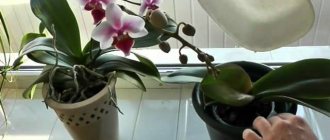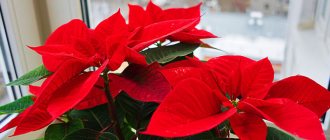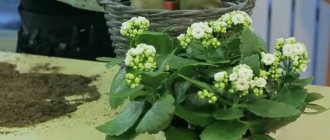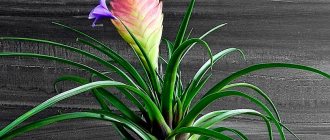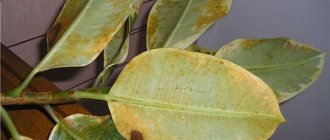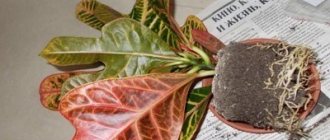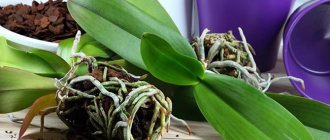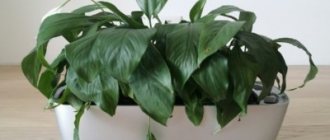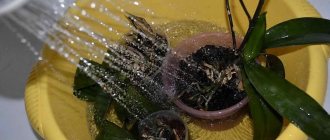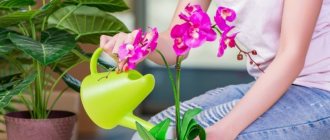Anthurium, or male happiness - description of the flower
Evergreen beautifully flowering, less often decorative-deciduous anthurium (anthurium) represents the Araceae (Aronnikov) family. According to various data, species diversity ranges from 500 to a thousand species, most of them are epiphytes. Plants in their natural environment are common in the humid tropics and subtropics, and therefore love warmth and moisture. The shape and size of the leaves of a flower are determined by the species; they can be whole or dissected, large or small, with veins that stand out in color or with a unique ornament.
The spadix-shaped flowers are equipped with a bract, often a large leaf, which makes the plant especially attractive. The color of the bract in different species varies from various shades of white to rich red, purple, yellow, and can be monochromatic, transitional, or variegated.
Anthurium owes its second name - male happiness - to the cob-shaped inflorescence, in which they once saw a phallic symbol. The plant is also often called a tail flower, flamingo, artist’s palette, and even a pig’s tail or devil’s finger.
Signs and superstitions associated with anthurium
In each country, anthurium is called differently. In France it is called Cockscomb, in the USA - Flower with a tail, in South American lands - Fire Tongue, and in China - Scarlet Sail. In Russia, it is often called the flower of Male Happiness because of its heart-shaped petal and proudly towering inflorescence-cob.
If you believe folk signs, then anthurium endows its owner with courage, strong energy, strength, bravery and nobility, which are inherent in every real man. In addition, this passionate flower supposedly increases libido and has a beneficial effect on male potency. You can find out this experimentally yourself.
Photo: https://pixabay.com/photos/plant-nature-flower-anthurium-2824288/
According to Chinese Feng Shui, the plant brings prosperity, money and success to the home. It is believed that it can only bloom in people with positive energy and will only bring happiness to decent people.
Due to the heart-shaped shape of flowers and leaves, anthurium is called arrows of love. It symbolizes family happiness and is often given to newlyweds.
It turns out that anthurium has a “second half” - a very similar flower from the same Araceae family, called spathiphyllum. People call it “women’s happiness.” They say that if both flowers are placed side by side or even planted in the same pot, then love and prosperity will reign in the family.
Unfortunately, this is not possible because these plants require different care. The male flower loves a lot of sunlight, albeit diffused, while the female flower feels much better in the shade. It’s the same in life – everyone seeks their own happiness on their own.
How to properly water anthurium at home, step by step photo
Experienced gardeners have developed a system of rules for watering indoor flamingo flowers. The “Code of Laws” determines the time of watering, its frequency, water requirements and other subtleties important for the quality development and flowering of the plant.
On a note! To prevent the anthurium from being damaged when the owner leaves for 10-15 days, spacer sticks are inserted into the pot, the soil is moderately moistened, placed in a transparent plastic bag and tied loosely.
How to determine that anthurium requires watering
An attentive florist quickly learns to detect a lack of moisture; the flower does not hide its dissatisfaction:
- the rich color of the bract fades, as if molting;
- the leaves lose their elasticity and shine and droop.
Note! “Male happiness” reacts sharply to the lack of moisture not only in the soil, but also in the air. This is especially important for young plants; they not only artificially maintain high humidity, but do not allow the soil in the pot to dry out.
Some gardeners weigh the pots to determine the need for watering: a dry substrate is much lighter than a saturated one. Instead of hassling with scales, you can pay attention to the angle of inclination of the leaves: if it is less than 45°, it’s time to water.
How often, what kind of water to water the flower and how much it should be taken
The flamingo flower is very sensitive to water quality. To avoid problems with his health, comply with the following requirements:
- soften hard water with 1-2 drops of lemon juice;
- water temperature – not lower than room temperature;
- Tap water must be allowed to stand for 3-4 days.
The ideal water for watering “male happiness” is rain or melt water; if possible, this is what is used. Experienced flower growers advise flavoring the water with several crystals of potassium permanganate every six months to prevent possible diseases.
The amount of water added to the flower and the frequency of watering are directly related to the following factors:
- Pot material. It is known that clay containers that are not covered with glaze not only absorb water, but also actively evaporate it. Flowers growing in such “apartments” need more water.
- Age of the tail flower. Adult specimens are watered when the soil dries out a little. Young ones need moisture more, so water them more often.
- Stage of development. The active growth and flowering phase requires more water than the dormant period.
The frequency of watering is affected by the temperature and humidity in the room, and the level of light. A well-lit plant located in a warm room is watered more often than one growing in a cool room with a lack of light.
Know! It happens that the substrate for growing anthurium turns out to be dense and heavy. In this case, before transplanting, the frequency of watering and its volume are reduced by a third.
You need to water the anthurium in the morning, this way it is easier to avoid stagnation of water.
What kind of water is needed for irrigation?
Anthurium is very sensitive to water. More precisely to its temperature. Watering it with cold water is strictly contraindicated. Warm water or water at room temperature is ideal. You cannot water a flower with tap water - this will negatively affect its health and appearance. Hard water is also unacceptable for a flower.
Additional Information! It is best to fill bottles with water and leave them at room temperature. It is best to use this water after 3-4 days.
Watering the plant depending on the type
A. climbing plant, which does not have a dormant period, is watered evenly all year round. In addition, it benefits from regular spraying of leaf blades, stems, and aerial roots.
A. Scherzer needs to reduce watering and stop spraying in winter.
A. Crystal is watered the same way at any time of the year.
A. Andre during growth requires regular, abundant watering, which is reduced in winter. Every day, the leaves of representatives of this species are sprinkled with water.
A. Linden is watered only through a tray; it is a very rare flower for home cultivation, and such watering is an additional precaution so as not to lose the exotic.
A. Hooker, a rare, although more hardy flower, in the active growth phase is watered often and abundantly, but not allowing stagnation of water. In a state of forced dormancy, the frequency and volume of watering is reduced.
A. Wendlinger is watered according to a standard scheme, all parts of the plant, except flowers, are sprayed 1-2 times a day in summer, in winter - every 2-3 days.
A. Veitch is watered in summer according to standard rules for anthuriums, in winter - very moderately. In addition, during the warm season, the leaves are sprayed with water daily; in winter, the procedure is carried out every other day.
Important! A thick layer of drainage will protect “male happiness” from stagnation of excess moisture.
What is the best way to water a flower - from above or from below?
A significant part of gardeners prefer bottom watering of plants - through a tray. The advantage of the method is that droplets of water do not remain on the leaves, stems, or aerial roots, which minimizes the risk of disease and does not spoil the appearance of the flower. However, water does not always reach the top layer of soil, i.e. aerial roots do not receive enough of it.
When watering from above, use special watering cans with a long spout without a sprayer. Water is added strictly around the perimeter of the container. At the same time, carefully moisten the moss covering the aerial roots. It is optimal to use both methods, upper and lower. And additionally covering the base of the flower with sphagnum will only improve the quality of watering.
On a note! For epiphytes (with a large number of aerial roots at the base), the soil is moistened from below; the roots located above the surface of the substrate are only sprayed.
Sprays that are beneficial for the flower-tail are combined with air spraying. This is especially important in winter, when the indoor atmosphere is characterized by a lack of humidity. Using a deep tray lined with expanded clay and filled with water simultaneously moistens the soil and air, i.e. the entire plant. At the same time, there are no risks of overflow and, accordingly, diseases associated with it.
Subtleties of watering seasonally
The frequency of watering and the amount of water added largely depend on the time of year. Almost all types of anthurium in winter plunge into forced dormancy associated with shortening daylight hours. With the beginning of spring, as the duration of daylight hours increases, active growth begins.
in winter
Water moderately, once a week. More attention is paid to maintaining high air humidity using accessible methods.
In summer
This is the most fertile season for tropical exotics. It is actively growing and blooming. Accordingly, it requires more moisture. Water it every other day or two. With good drainage, you don’t have to spare water, the main thing is after 20-25 minutes. After watering, drain all excess from the tray and dry it. The above-ground parts are sprayed daily, in extreme heat up to 2-3 times a day.
in autumn
Monitor the activity of the flower. If it continues to flower and grow, water in the summer mode. If new flower stalks and leaves do not appear, watering is gradually reduced.
in spring
Before active growth begins, water according to the winter schedule. As soon as the flamingo flower comes to life, the amount of moisture supplied is increased.
Care measures
Many people are interested in how to grow anthurium at home, and whether it is difficult. Caring for anthurium is not at all difficult; this plant is unpretentious.
Temperature
Homemade anthurium has been recognized by flower growers as an unpretentious plant. If you create all the necessary conditions for a flower, it will actively grow, develop and delight with its decorative appearance. The culture in natural conditions is located in tropical zones.
Therefore, the temperature in the room should be between twenty-two and twenty-four degrees. If this is difficult to achieve, then the plant will be comfortable in a room with a temperature of at least fifteen degrees.
Anthurium at home does not respond well to drafts and sudden changes in temperature.
If the crop is placed on a windowsill where there is cool air, the rhizome will begin to rot. This problem can easily be avoided if you place a piece of foam under the flower pot.
Lighting
Blooming anthurium in nature grows under tall crops, that is, in the shade. Direct rays of the sun have a negative effect on the plant. Anthurium leaves will receive severe burns, which will kill the flower. At home, it is best to place pots in the West or East of the room. This growing condition applies not only to flowering crops, but also to decorative foliage crops.
If all the window sills in the house are from the southern part, then the gardener can independently arrange comfortable conditions for the anthurium. You can move the pot a little further from the window opening, or make shading on the window.
The flower will benefit from fresh warm air in the summer. The pots are taken outside or onto the balcony for a while. It is necessary to organize good protection for the crop from the sun, precipitation and wind.
Flower growers often notice that a pressing problem in growing anthurium is the drying of the leaves. This violation occurs in several cases:
- Burns on the plates of a brown tint, which is accompanied by dried soil, are a sign of an excess of sunlight;
- Yellowing of the leaves with further drying indicates a lack of lighting.
Such problems may arise if the pot is placed in the northern part of the window or in winter. To improve the condition of the plant, it is enough to install additional artificial lighting for the crop.
Watering
Flower growers say that the plant must be watered abundantly and often. This opinion is wrong. The entire family to which the crop belongs requires moderate watering. You should not allow excess moisture, but you should also not overdry the soil in the pot.
If the soil is too wet or there is stagnation of liquid in the soil, then the root system begins to rot and late blight develops.
The anthurium overflowed, what should I do? Excess water in the pan must be removed promptly. It is important to strictly monitor watering if the room is cool.
In the summer, when the heating systems are on, and during the period when additional lighting is on, watering is increased more often. The soil is also treated with a damp sponge.
If the water for irrigation is hard or watering is done too often, then the crop will react to this. The leaves will begin to show dark spots on the blades.
The liquid can be made softer by adding citric acid granules to it. It is best to use water at room temperature that has stood for several days.
Humidity
The rules for comfortable growing a plant include not only monitoring soil moisture, but also monitoring air humidity. Beautiful and timely flowering of the crop will occur only at seventy-five or eighty-five percent humidity.
To create such conditions indoors, you need:
- Spray the leaves of the plant with warm water;
- Use a special device to humidify the air;
- Place wet expanded clay in the tray of the pot.
To prevent the leaf blades from showing black spots, you need to regularly wipe the leaves with a cloth. There should also be a dry surface on the flowers. Liquid and moisture should not get on those types of anthurium that have matte plates.
During the heating period, it is better to install the culture near a special device for humidifying the air, an indoor fountain, or in a bathroom that has good lighting.
The soil
When growing a flower indoors, the soil should be light and structured. The acidity of anthurium soil is between five and a half and six. In nature, the plant is accustomed to feeding on moisture and nutrients not only from the ground.
The trunks of nearby trees help the anthurium to obtain nutrients. Therefore, if the substrate is too heavy, the rhizome will begin to rot.
A good soil for the crop would be a mixture of:
- Peat;
- Leaf soil;
- Sand;
- Conifer bark.
Crushed coal is used as an addition. It allows you to disinfect the soil.
Pots for planting flowers should not be too large in volume. A prerequisite is the material from which the pot is made. Only plastic is like that. It should also have holes for drainage. A layer of expanded clay is installed at the bottom so that excess liquid does not stagnate in the ground, but is removed into the pan.
You can plant anthurium in orchid soil.
The crop must be fed regularly. You can add garden soil to the pot, which is pre-disinfected.
At the time of active growth and development of the flower, fertilizers are applied more often. Carrying out the procedure twice a month is enough. Minerals and organic matter are used as fertilizing. They need to be used one by one. If the type of crop goes dormant in winter, then fertilizing is not applied, and watering is carried out much less frequently.
It is not recommended to additionally water and use fertilizers for the plant in winter, even if it blooms continuously.
The nuances of watering after transplantation
According to the rules, before placing a flower in a new pot, water it abundantly, then add water again - this time to the new substrate.
How long does it take to water for the first time?
When transplanting, the soil is saturated with moisture to the limit, so the next scheduled watering is carried out no earlier than after 5-7 days. It is best to check how dry the soil is before watering with a dry stick or a special indicator.
Attention! If during replanting a large number of roots (dry, broken, rotted) were removed, the new substrate is moistened to a minimum or left completely dry, saturating the drainage with moisture.
What to water with
Since there are enough nutrients stored in the new substrate, water only with water, without any additives in the form of fertilizers. But it is permissible to add a few drops of a stimulant to the water so that the plant can more easily endure the shock and quickly return to normal development.
Solving problems and difficulties during cultivation
While growing anthurium, you may encounter some problems and difficulties, the timely solution of which will help cure and restore the plant.
Why do the leaves dry out and turn yellow?
Yellowness and dryness of the leaves indicate that the plant is either in a draft or simply frozen. By restoring the temperature regime and moving the pot to another place, you will bring the flower back to life.
Why do anthurium leaves crack?
If the leaves are cracked, then the soil or the quality of the water used for irrigation is not suitable for the plant. The flower should not be watered with fresh running water. Before watering, the liquid must stand in the room for at least a day.
Why doesn't anthurium bloom?
Lack of flowering can be caused by insufficient lighting, disturbed temperature conditions and lack of fertilizing. Simply fertilize the soil and move the pot to a suitable room with more light. Also, anthurium may not bloom if its root system is significantly smaller in volume than the substrate. In such a case, simply transplant the plant into a smaller pot.
What to do if there are brown spots on the leaves
There may be several reasons for this phenomenon:
- excessive watering;
- incorrectly selected soil;
- the plant is too hot and dry (the tips of the leaves darken);
- anthracnose fungus (there is a small black dot in the center of the spot).
Once proper care is restored, the stains will go away. If the flower is infected with fungus, spray the leaves with an antifungal agent, following the instructions on the package.
If the leaves have darkened completely, it means that you are watering the anthurium with too cold and unsettled water.
How to update an old anthurium
As the anthurium grows, old leaves die off and new ones form on top. Due to this phenomenon, the flower loses its presentable appearance. To restore the plant's attractiveness, cut off and root the top. The procedure is convenient to do during transplantation.
Why do Anthurium flowers turn green?
For some varieties this is a natural process that occurs at the end of flowering. If you carefully remove the green flowers, it will be easier for the plant and it will bloom again faster. If the process is regular, the rules of care may have been violated, and if restored, the problem will go away.
If the roots have rotted, how to save the anthurium
If the roots are completely rotten, try to restore the plant by rooting cuttings. Perform all actions in the same way as during reproduction.
Why does anthurium grow poorly?
If the anthurium begins to grow slowly, think about whether you have changed its location, due to which the quality of lighting or watering has changed. Mineral fertilizers and fertilizing, as well as the resumption of proper watering and lighting levels, will help restore the flower.
Why does anthurium have small leaves and flowers?
With a similar phenomenon, anthurium indicates a lack of nutrients, moisture or lighting. Feed the plant, restore watering and lighting, and the flower will grow.
Why does anthurium wither?
It happens that the flower begins to emit an unpleasant odor. The problem can be caused by either hypothermia of the plant or fsarium disease, which appears from an excess of liquid, as well as infection from pets or dirty hands.
How often does anthurium bloom?
Anthurium blooms for more than six months, resting only in the harsh winter. The first flowers bloom as early as March and can remain on the stems for several months. When cut, anthurium flowers can last in water for about a month.
Growing an anthurium is not difficult if you follow all the subtleties of care: install the flower in a suitable place, regularly feed and replant, and observe watering standards. The plant reacts instantly to any violation of the regime. Before purchasing an anthurium, consider whether you can provide the flower with proper care.
Features of watering after purchase
Transport soil, which is used to fill containers for selling flowers, incl. Anthuriums have their own characteristics of moisturizing, which are difficult to implement at home. In order not to harm the newly purchased anthurium, replant it immediately. Watering the transplanted plant is carried out as described above (after regular transplantation).
Note! Although the frequency of watering after transplantation is reduced, this does not apply to moisturizing the above-ground parts of the plant. They are sprayed as usual.
Types of anthurium
You already know that breeders, starting from the end of the nineteenth century, did not waste time, so the world is actively growing about eight dozen different varieties of hybrids, not forgetting about natural species. Let's take a look at the most popular ones.
Anthurium Andre
In the northern part of the Andes, the French botanist Edouard Andre discovered a previously unknown flower of amazing beauty, which he named in his honor - Anthurium Andre. This is one of the most popular and beloved plants by gardeners, which is bred as an indoor flower, as well as for sale as freshly cut. It can stand in a vase for an unusually long time and not fade for three to four weeks.
We can say that the history of anthurium began with this species. What is he like?
At home, its maximum height is 60-80 cm, however, no more is needed. But this happens rarely; classic bushes do not exceed 35-40 cm.
Photo: https://pixabay.com/photos/flamingo-flower-red-tropical-exotic-1329247/
The leaves are dark green, heart-shaped, dense, leathery and glossy. They look polished and shine in the sun.
Bright yellow small flowers are collected in one ear, which is framed by a scarlet blanket with a wrinkled glossy structure.
Anthurium Scherzer
The low-growing flower, compared to other species, is exceptionally unpretentious. It can be recognized by its spiral-shaped “tail” and rather small size – it reaches a height of about 30 cm.
The orange or red inflorescence spadix has a curved shape and somewhat resembles a worm or a pig's tail. The bedspread can be scarlet, with a variegated dotted pattern, sky blue, two-color and even chocolate. It is slightly heart-shaped and almost inverted towards the bottom. The leaves are glossy, shiny, dark green.
Anthurium Crystal
This is an ornamental deciduous species that is famous for the beauty of its leaves. They are large, spreading, oval, but pointed at the apex. They have a velvety matte surface on top and are covered with red-brown hairs on the inside.
The main color of the outer surface of the leaf is from dark to bright green. The central vein is convex, wide, olive-silver in color. Secondary veins of the same shade extend from the central vein to five on each side, bend and converge at the tips at the apex. The veins form a contrasting pattern on the darker surface of the leaf, which is what this variety is famous for.
Flowering against a background of magnificent leaves is unattractive. The peduncle is long, cylindrical, light or red-violet in color. The blanket is green, merging with the leaves, narrow and inconspicuous.
Anthurium dissected
Another representative of the decorative deciduous species. The large leaves of the classic anthurium seem to have been cut into pieces by a sharp knife. They became spreading, in the form of many “fingers” and with slightly wavy edges.
The plant itself is a vine with a thin stem, from which petioles with multi-dissected leaves extend.
For indoor use, the plant is valuable because it easily tolerates dry air and insufficient lighting.
Fertilizing during watering
If “male happiness” is fed with ready-made fertilizers (from the Kemira, Feritka, Agricola, etc. series), they are dissolved in water for irrigation in recommended doses.
Flower growers who have dedicated their lives to breeding the flamingo flower recommend alternating root feeding with mineral complexes with foliar feeding. A reduced portion of complex fertilizers is included in the water for spraying. This allows nutrients to quickly penetrate the tissues of leaves, stems, and peduncles.
Advice! After 20-30 minutes. After feeding, wipe the leaves with a slightly damp cloth so that no “salty” traces remain.
Problems arising from improper watering of anthurium
A single overflow due to carelessness will not cause much harm to the flower. However, regular excess moisture is the cause of various exotic diseases: root rot and powdery mildew.
Signs of excess moisture:
- slow growth;
- the appearance of a grayish-white coating on the inflorescence leaf;
- unpleasant smell from the pot;
- unpleasant brown spots on the roots, their sliminess;
- darkening of the leaves, the appearance of brown spots on them.
Insufficient watering leads to rust damage, individual areas of the leaf blades change color to dark brown, the size of the spots gradually increases, covering the entire leaf. The affected parts lose elasticity and sag.
Lack of moisture is expressed by the following symptoms:
- the flower slows down;
- the leaves bend, turn yellow, and curl up;
- existing inflorescences quickly fade.
When watered with inappropriate water (hard or cold), the flamingo reacts by the appearance of white, clearly visible dots on the leaves.
Small cracks on the leaves appear with insufficient or excessive watering. They can cause bacterial or viral infections.
Note! The main reason for the death of anthuriums is excessive watering!
Diseases and pests
Anthuriums hardly get sick and are practically of no interest to insect pests. Very rarely, but they can be attacked by the following parasites.
- Spider mite. A tiny red insect that resembles a spider. It settles on the underside of leaves and feeds on their juice. It can be suspected due to the thinning and yellowing of the leaf, but detected due to the presence of characteristic cobwebs with which the tick entangles its habitat.
- Aphid. It is easier to see because it is very numerous and reproduces at an incredible speed. It prefers to settle on young shoots and flower buds - they are the most delicious.
- Shield. Brown leathery growths on the leaves. Hidden under the shield-shell is a parasite that devours the sweet pulp.
If you suspect that your plant has been attacked by parasites, then make a strong soap solution from laundry soap, dilute it with hot water and sprinkle the leaves and stems with a warm shower.
If this method does not help, then you will have to use heavy artillery and buy insecticide chemicals at the flower shop. They are bred according to the instructions, and they must be sprayed on the plants several times at intervals of 7-10 days to ensure complete destruction of pests.
As for diseases, anthurium is susceptible to root rot due to excessive heavy watering, as well as anthracnose, a fungal disease that is characterized by drying out, depletion and death of leaves.

